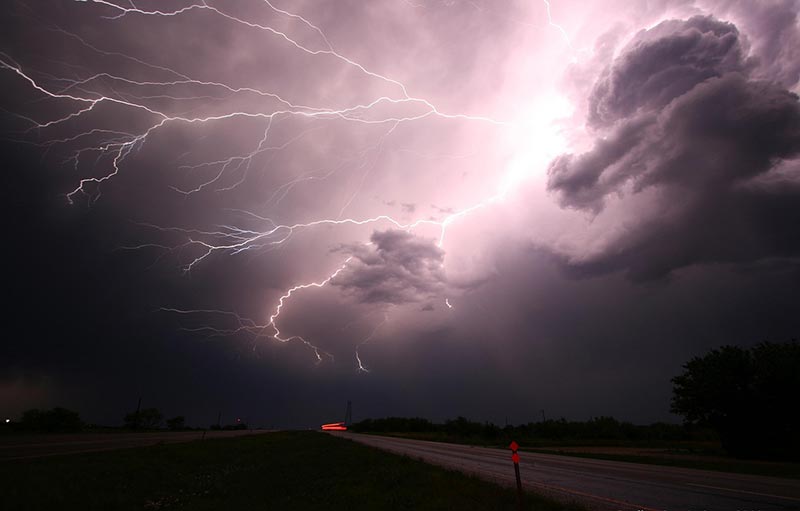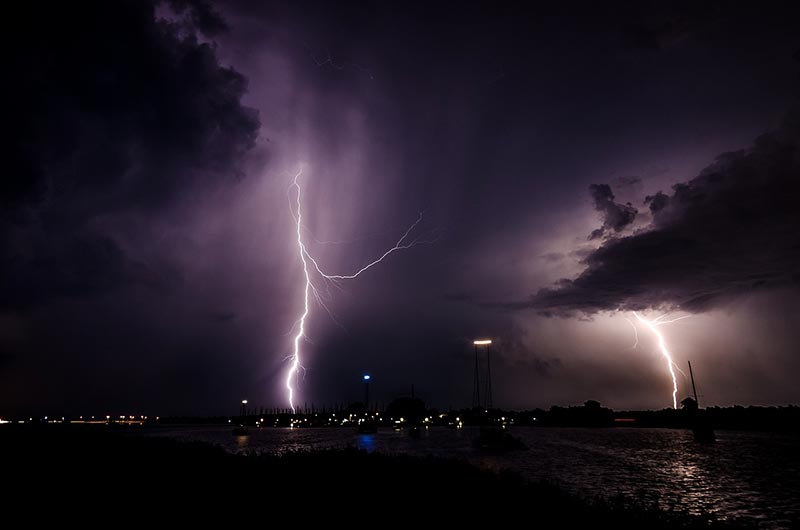How Much Energy Is in a Lightning Bolt? Facts & FAQs
-
Pete Ortiz
- Last updated:

If you’ve ever lived in the US (or if you’re a permanent resident) you know the rumbles of thunder and the flashes of lightning are considered a climate staple. This is very concerning, given we’re talking about a phenomenon that packs 4 million volts of electricity at a minimum, and can heat up the air to 54,000ºF.
Through Vaisala—a lightning research institution—we learned that 2021 saw an exponential spike in the number of lightning strikes1 that were experienced around the country. Their latest report intimated that the US alone experienced over 194 million lightning strikes last year, compared to the 170 million strikes detected in 2020. Thus, giving us a difference of 24 million.
For the record, this isn’t an estimation but accurate data, seeing as they’ve always invested in high-tech lightning detection systems that have been tried and tested.
As per their findings, a single bolt of lightning has the potential of delivering approximately 5 billion joules of energy2. And that tracks with the findings of several other scientists, including Andrew Crosse. Crosse, famously known as the “thunder and lightning man,” was an English scientist who many people assume inspired the works of Frankenstein.
Unfortunately for you, that history lesson is scheduled for a different time. Today’s focus is on the energy generated by lightning, and nothing else. How about we start by defining it?
What is Lightning?
Back in the day, we used to think that thunder was what actually caused the flashes of lightning. When in reality, it’s the other way around. It’s now a known fact that lightning is essentially an electrical discharge that has the potential to heat up the air around it to 54,000ºF.
To put that into context, 24-karat gold can only be melted at 1947.52 ºF. And that’s pure gold that we’re talking about.
Because this heat is too extreme for the air surrounding the clouds, it causes an explosive expansion that immediately creates a shock wave. That wave is what morphs into the booming sound that we all know as “thunder.”

How Are Lightning Bolts Produced?
It all starts with the ice crystals within the storm. That turbulence usually forces them to move in all sorts of directions, violently crashing into each other. As a result, the electrons within some of the crystals are inadvertently detached from the protons and attached to other crystals.
Electrons are what we call the negatively charged subatomic particles of an atom. Scientists like to see them as the primary carriers of electricity in solids, liquids, and even gasses. Protons are also subatomic, but carriers of positive charges.
When the negatives leave the crystals, that deficiency causes those crystals to become positively charged, thus forcing them to move to the top of the cloud. At the base of the cloud, you’ll only find the negatively charged crystals, yearning for more positive carriers.
Because they know they can’t access the carriers at the top, they’ll resort to what’s available on the ground below them—and that’s where we come in.
As the negative carriers underneath the cloud grow in numbers, something called a “stepped leader” starts forming. The leader is basically a flow of negative charge that’s to be sent to the planet’s surface, to seek help from other positive carriers.
And they’ll certainly get the help because the protons found on the ground are very charitable. They’ll eventually get the signal, start flowing upwards, and meet with the stepped leader somewhere in between.
This upward flow of current is scientifically known as the return stroke. And it’s actually the bright flashes that we often see, right before you hear the thunder rumbling.
By the way, lightning and thunder always occur simultaneously, but the reason why we normally see the flash before hearing any sound is that sound waves travel relatively slower. In the air, light travels at speeds of 300 million m/s, while the sound waves can only manage 332 m/s.
Is It Possible to Harvest Lightning Energy?
First off, it’s important to note that lightning generates, or rather carries with it, three very different forms of energy. You’ll be getting sound, heat, and the big one, which is electricity. For years now scientists from all walks of life have wondered and even tried to explore the possibility of harvesting lightning.
If you’re an avid reader, you’ve probably seen articles with headlines such as: “What if lightning is the key to powering electrical vehicles efficiently?” Or… “Can’t we find a way to leverage the intense heat produced by lightning, to generate sufficient power to run turbines?”
Some have even gone as far as asking, “Can the sound produced by thunder generate the requisite amount of power needed to engineer carbon-free hydrogen fuel?”

Harvesting Electricity from Lightning
You’ll be glad to hear that we’ve made efforts to harvest and even store this form of energy using magnetic capacitors and high-voltage switching circuits. The most notable system applications that were patented for this specific purpose were filed in 2013 and 2018.
Both of them came with antennas that were meant to capture lightning strikes, and then conduct the charges through some sort of insulated chamber. The chamber had a fluid that was to be heated by the same energy harvested.
The sad news is, after a number of runs, both of them proved to be unsuccessful. Could it be due to the fact that harvesting electrical energy from lightning is a big ask? Probably. But some scientists are of the opinion that this undertaking isn’t as difficult as inventing a fusion reactor.
Quite frankly, harvesting lightning’s electricity has never been an issue for us. We have Benjamin Franklin to thank for that, as he was the one who invented rods that attract, capture, and direct lighting to the ground.
Our main problem is how to tame it. If you can figure out the best way to step down the bolt’s electrical energy to safe and manageable levels, you’ll be one of the geniuses to ever grace our history books.
“Can’t we use our national electricity grid?”
Good idea, but it’s not big or strong enough to hold 4 million volts. You see, the grid has high-tension transmission lines moving from our power-producing plants, through several substations, and to our homes.
From the plant, they normally carry around 345,000 volts. Those volts are then stepped down once they get to the substations and then stepped down again at the neighborhood level. By the time the power gets to your property, you only have 120 volts to work with.
Harvesting Heat Energy from Lightning
The temperature of the sun varies depending on the layer. At its core, it’s estimated that the temperature is 15 million degrees Celsius, which is roughly 27 million degrees Fahrenheit. But on its surface, you’ll only be getting 10,000 degrees Fahrenheit, which is the equivalent of 5,500 degrees Celsius.
If you compare those numbers with the heat energy emitted by lightning, you’ll quickly realize that its energy is even hotter than our sun’s surface. The good news is that recent advances in the field of electrical engineering have indicated that we’re at the cusp of finding a way to capture this mega-heat.
We once thought it was impossible, given that magnets—which play a vital role in the generation of electricity—often lose their magnetic force in the presence of heat. But not so long ago, we discovered a new element that’s also capable of transforming heat energy into electricity. That element is the paramagnon, and it’s being treated as the new heat-to-electricity semiconductor.
Sadly though, it’s nothing more than a theory at the moment. For it to be a workable product, we’ll first have to test it on the different low-heat sources that we currently have. A good example is the waste heat emanating from manufacturing plants and vehicles.
Just to show you how much energy we’re talking about, here’s a comparison chart of other heat sources:
Heat Energy from Various Sources
| Source | Temperature |
| Sun | 15 million ºC (surface temperature) |
| Earth | 5,200 ºC |
| Basalt Lava | 1,100–1,250 ºC |
| Magma | 1,000–1,500 ºC |

Harvesting Sound Energy from Lightning
Converting electricity into sound waves is no longer news. It’s actually what we’ve been doing, so as to communicate using our telephones. Reconverting those waves back to electricity is also very possible. It only takes a couple of minutes of scouring the internet to come across a journal article that tries to explain how that could work.
It is estimated that a single thunderclap can register 100 to 120 decibels—those decibels are equivalent to 10 times the sound produced by a pneumatic jackhammer drill.
If you get exposed to that level of noise for at least 3 minutes, your life will drastically change. You’ll never be able to hear anything again, as all the features in your inner ear will be completely damaged.
“Is the sound produced by lightning dense in energy?”
Nope. The amount of electricity that you’ll manage to extract from that harvest will only be sufficient to charge a mobile phone or an iPod case. That’s why we haven’t invested too many resources in researching ways of harvesting sound from lightning. We have far better sources of sound energy, such as traffic.
If we wanted to harvest 120 decibels, it’s easier to get them from any one of these instruments:
Sound Energy from Acoustic Instruments
| Instrument | Decibels |
| Trombone | 85–144 dB |
| Cello | 85–111 dB |
| Trumpet | 80–110 dB |
| French Horn | 90–106 dB |
| Flute | 92–103 dB |
Conclusion
We’ll be signing off by reminding you that lightning has three forms of energy: sound, heat, and electricity. We’ve always wanted to harvest and tame electricity more than the other two, but we’re yet to find a way. Our scientists keep telling us that it’s not a matter of “if” but “when,” and we believe them. Seriously though, what other option have we got, other than to hold out hope?
See also: How Much Ice Can Power Lines Handle: All You Need to Know!
- How hot is the sun? | Space
- WO2013178973A1 – Power generating device using lightning – Google Patents
- Why is light faster than sound? – Morgridge Institute for Research
- Try Not to Sweat! This is Actually the Melting Point of Gold – Science Struck
- Lightning: A Natural Energy Source | Haihui Joy Jiang | Ph.D.
- Vaisala reports 194 million lightning events in the US in 2021, an increase of 24 million from 2020
Featured Image Credit: WikimediaImages, Pixabay
Contents



